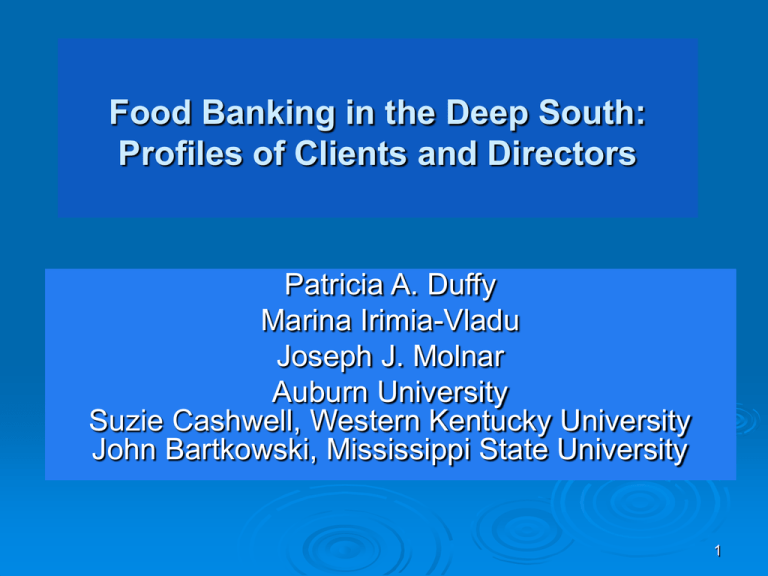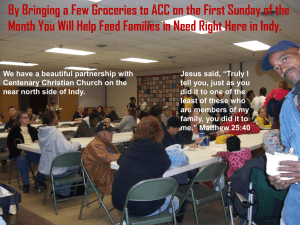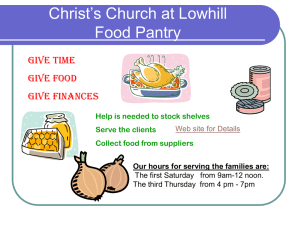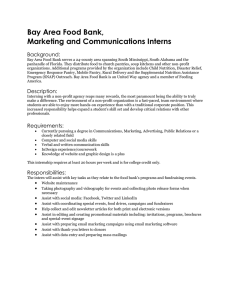Food Banking in the Deep South: Profiles of Clients and Directors
advertisement

Food Banking in the Deep South: Profiles of Clients and Directors Patricia A. Duffy Marina Irimia-Vladu Joseph J. Molnar Auburn University Suzie Cashwell, Western Kentucky University John Bartkowski, Mississippi State University 1 Source: St. Cecelia Catholic Church, Iselin, New Jersey 2 Source: New Path Outreach, Tipp City, OH 3 Study Objectives Profile of Food Pantry Directors, Alabama and Mississippi Profile of Food Pantry Clients, East Alabama area 4 Some Questions of Interest Do food pantry clients feel stigmatized by use of food pantry? Why are people using food pantries? Are food pantries a short-term or a longterm form of aid? Are directors sympathetic or judgmental? Are food pantries preferred to food stamps by the people who use them? 5 Data Sources 2002 mail survey sent to 500 food pantry directors in Alabama and Mississippi. From each state 250 food pantries were randomly selected. 235 usable surveys returned, 50 undeliverable. 1999 face to face interviews with food pantry clients in East Alabama. 10 clients from each of 6 metro-area and 6 nonmetro area pantries selected. 96 completed surveys. 6 Director Profile Questions Are they secular or religious in nature? What types of local community agencies are affiliated with food banks in the Alabama-Mississippi area? What are their organizational characteristics and what populations do they serve? 7 Director Profile Questions What types of people lead such agencies? Are food agency directors predominantly white or African American, male or female? How educated are they? What is their household income? 8 Director Profile Questions What social welfare attitudes are manifested by food agency directors? What do pantry directors think about their clients? 9 Pantry Profiles 75% church sponsored or religious-linked organizations 10 Service Area 22% 15% Rural Mid-Sized MSA 63% 11 Director Profiles 64% female 36% male 12 Director Profiles 63% Caucasian 37% African American 13 Director Profiles 21% 44% High School or less Some College College Grad 35% EDUCATION 14 Director Profiles 100% 90% 80% 70% 60% 50% 40% 30% 20% 10% 0% Never Occasionally A few times a month Once per week or more CHURCH ATTENDANCE 15 Director Profiles 27% 31% Below $30,000 $30,000-$60,000 Above $60,000 42% Household Income 16 Photo Source: Montgomery Area Food Bank 17 Director Profiles—Attitudes Directors were asked a series of questions dealing with their attitudes about poverty in general and food pantry clients in particular. 18 Directors’ Attitudes about Poverty. Strongly Agree Unsure Disagree Strongly No Agree Disagree Response pct pct pct pct pct pct 1 Poverty is caused by prejudice and discrimination against minority and individuals 3 12 14 42 25 4 2 Poverty is caused by the failure of society to provide good schools for many Americans 4 20 15 44 15 3 3 23 9 42 20 3 4 Poverty is caused by loose morals and drunkenness. 2 9 6 41 40 2 5 Generally speaking, we are spending too little money on welfare. 8 19 24 35 12 2 3 Poverty is caused by lack of ability and talent among poor people. N=235 19 Directors’ Attitudes About Food Pantry Use Strongly Agree Agree Unsure Disagree Strongly No Disagree Response pct pct pct pct pct pct 1 There are too many people using food pantries that should be working. 12 21 17 37 12 2 2 Many people getting food are not honest about their needs. 12 37 18 28 3 3 9 43 11 29 6 2 4 People who use food pantries are just having bad luck. 0 18 17 45 16 4 5 Most people who use food pantries and who are able to work are trying to find jobs. 9 51 18 18 3 3 6 Food pantry use is caused by low wages in some businesses and industries. 12 55 15 2 5 3 Food pantry use is often caused by the sickness and physical handicaps of poor people. N=235 12 20 Overview The typical food pantry director is a well-educated white woman with a medium household income. She does not have strong opinions about the causes of poverty, does not think we spend too little on welfare, and may harbor some suspicions about the honesty of some clients. 21 Food Pantry Clients Who are they? Why do they use a pantry? Are they satisfied with pantry services? What government programs do they use? What hardships do they face? Are rural and metro-area clients different? 22 The Study Area Agencies of the East Alabama Food Bank are found in Lee, Macon, Chambers, Tallapoosa, Bullock, Randolph, and Russell Counties, with the greatest concentration of member agencies in Lee County. The urbanized portion of Lee County, where the East Alabama Food Bank is located, has two neighboring cities (Auburn and Opelika) with combined populations of over 50 thousand people. Ten out of twelve pantries were associated with churches or religious groups. 23 Interviews Six metro area (Auburn-Opelika) and six non-metro area pantries were selected via probability in proportion to size. We selected 10 clients from each agency for face to face interviews. We were able to complete 96 interviews. The remainder were no-shows or refusals. Most interviews were conducted at the pantry site. 24 Differences in Clients Very few responses were statistically different across metro, non-metro clients. In the paper, responses for each sub-group are reported, as well as the overall response pattern. 25 East Alabama Clients Are: Women (89%) Poor (85% have family incomes below $20,000) Of diverse ages Often poorly educated (43% did not finish high school) Frequently African American (61%) Likely to be single parents (59%) 26 37% of directors reported being African American, compared to 61% of EAFB clients interviewed. Photo Source: America's Second Harvest 27 Employment Characteristics 35 % disabled 8% retired 19% working full-time 8% working part time 13% homemakers 14% unemployed 2% students 28 Hardships Within the past 12 months have you had to choose between paying rent or mortgage and buying food? Sometimes Often Never pct 32 6 62 Within the past 12 months, have you had to choose between paying for utilities and buying food? Sometimes Often Never 38 11 51 Within the past 12 months, have you had to choose between paying for medicine and buying food? Sometimes Often Never 23 6 71 29 Food Hardships pct I worried whether food would run Never true out before I got money to buy Sometimes true more. Often true 31 58 11 Do you ever run out of money to Never Sometimes purchase food? Often 21 45 34 Do you have enough of the kinds Yes of food you want to eat? Yes, but not always the kinds we want Sometimes not enough Often not enough 25 55 14 6 30 Food Hardships In the last 12 months: pct Did you ever go to someone’s home for a meal because you were out of food? Never Sometimes Often 63 31 6 Did you ever send your child to someone’s home for a meal because you were out of food? Never Sometimes Often 80 17 3 Did you ever cut the size of your Never meals or skip meals because there Sometimes wasn’t enough money for food? Often 54 33 13 Did you not eat for a whole day because there wasn’t enough money for food? Never Sometimes Often 80 15 5 Did you ever cut the size of the children’s meals because there wasn’t enough money for food? Never Sometimes 89 11 Did any of the children ever skip a Never meal because there wasn’t enough Sometimes money for food? 98 2 Never Did your child/children ever not eat for a whole day because there wasn’t enough money for food? 100 31 Government Programs pct Food Stamps 35 TANF 4 Free or reduced-cost meals for the elderly 6 Reduced-cost meals at school 41 Free or reduced-cost food at a day care or Head Start program 8 Food through the WIC program 20 SSI benefits 43 Medicare 32 Medicaid 47 32 Food Stamps Only 35% of respondents used food stamps. Follow-up questions explored why 65% of respondents did not use stamps. We also asked food stamp recipients about their stamps. 33 Exploring Non-Use of Stamps 11 respondents had stamps stopped in previous year; 4 had income increases, 1 chose to stop, the rest gave no reason. 21 respondents had applied for stamps; half had been rejected, the rest were waiting to hear. A few respondents reported that applying for stamps was not worth the trouble. 34 Experiences with Stamps 19 of the 33 food stamp recipients had used stamps for more than 2 years. About half received less than $100 per month. Most said the food stamps did not last all month. 17 of the 33 reported having their benefits cut in previous year (1998-1999). 35 Food Pantry Use pct How often can you receive food at the pantry? Weekly Monthly Less Often Not told Other 19 33 16 19 13 How often do you get food from Once a week the food pantry? Once a month Every now and then 9 27 64 How long have you been Less than 1 month receiving food (or food 1-3 months assistance) from this food pantry? 4-6 months 7-9 months 10-12 months More than 12 months 7 16 12 4 17 44 Do you think you will have to come to this pantry to get food three months from now? Yes I hope not No Have you received food from Yes more than one food pantry in the No last 12 months? 57 23 20 27 73 36 Food Pantry Satisfaction pct How satisfied are you with the quality Very satisfied of food provided by the food pantry? Satisfied Somewhat satisfied Dissatisfied Very dissatisfied 48 35 14 2 1 Very satisfied How satisfied are you with the amount of food provided by the food Satisfied Somewhat satisfied pantry? Dissatisfied Very dissatisfied 40 40 15 4 1 How satisfied are you with the variety Very satisfied Satisfied of food that is available to you? Somewhat satisfied Dissatisfied Very dissatisfied 36 43 19 1 1 37 Food Pantry Satisfaction Is it hard for you to find transportation to get to the site? Sometimes Always Other Never 22 5 3 70 When you come to the pantry, are you treated with respect? Some of the time Most of the time All of the time 1 4 95 I feel like I am being judged because of my situation every time I go to the food pantry. Strongly agree Agree Undecided Disagree Strongly disagree 1 5 6 54 34 If you could get as much food at a food pantry as you get with food stamps, would you prefer to use the food pantry? Food Stamps Food Pantry 59 41 38 Significant Metro/Non-Metro Differences About the same percentage (28%) of metro and non-metro respondents work for wages, but the non-metro respondents are more likely to work full time. Non-metro respondents were more likely to get SSI (52% versus 34%). Non-metro respondents report being able to get food at the pantry more often. Metro area respondents more likely to run out of food. 39 Significant Metro/Non-Metro Differences Non-metro respondents more likely to have used pantry more than one-year (61% versus 28%). Non-metro area has larger group of older clients. Non-metro respondents more likely to “strongly disagree” that they feel judged. Non-metro respondents would prefer food pantry to food stamps (51% compared to 29% of metro respondents.) 40 Long-Term Clients What factors raise the likelihood of being a long-term client? Logit model Dependent variable, 1 if used pantry a year or longer, 0 otherwise. 41 Model Results Variable Constant Run out of food often Dummy for low education (less than GED or high school diploma) Family size Rural Single parent Race-white -1.058 0.48 Standard error 0.703 0.522 Marginal Effect -0.258 0.117 0.515 0.035 1.783** -0.226 -1.539** 0.477 0.124 0.518 0.493 0.559 0.125 0.008 0.435** -0.055 -0.376** Coefficient Standard error 0.169 0.127 0.116 0.030 0.126 0.120 0.136 ** Significant at .01 level Rural, African-Americans are more likely to be long-term clients. 42 Conclusions Churches are highly involved in food pantry activities in Alabama and Mississippi Although directors may harbor some suspicions about clients, the clients in East Alabama felt they were treated with respect. Clients tend to be low-income women, raising children as a single parent. 43 Conclusions Directors tend to be well-educated, highly church-involved women of medium household income. Disabilities, poor education, and other problems may prevent some clients from achieving food security without assistance. Only 35 percent of clients used food stamps. 44 The Policy Picture Food pantries in many areas are already strained to meet demand. If demand growth continues, especially with another economic downturn, the private sector probably will be unable to bridge the hunger gap. Expansion of the TEFAP program (federal program providing food to food banks) might help, but if the government role expands, food pantries could lose their flexibility. 45 The Policy Picture In our study, we were unable to find out why so few food pantry clients (35 percent) were using food stamps. We did find that some had applied and been refused, and others said they were not eligible. Others did not give a reason for not applying. The growth of food banking leaves open the question of whether our government policies are providing a sufficient safety net. 46


